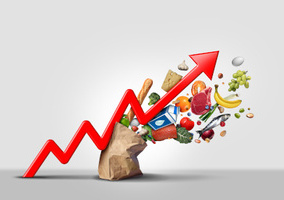Over the last decade, growth has experienced unprecedented favourable conditions. There’s been globalisation, low interest rates and lots of change: technological advances, new business models and shifts in consumer demand.
Some factors have recently become more challenging, but change remains a powerful growth driver. We are optimistic that over the long term, we will continue to see change reflected in substantial share price growth for the few companies most successful at harnessing it.
As the economist Joseph Schumpeter described it, businesses and societies are in a constant state of innovation and transformation. He suggested that a process of creative destruction is a natural and essential element of capitalism as it lets more efficient technologies and business models replace older ones.
Entrepreneurs drive the activity by introducing novel products, services and technologies that disrupt existing markets and industries. Through creative destruction, new industries and markets emerge, and the economy and stock market are constantly evolving. Schumpeter said this creative destruction helps to keep businesses and markets competitive and allows for innovation and growth.
Humans, a species of innovation
Modern humans, or homo sapiens, evolved around 300,000 years ago in Africa and have since expanded onto nearly every type of climate and terrain on Earth. We are now comfortably the planet’s apex species; these days, we’re even dashing about in space. Impressive progress for a once unremarkable primate.
Thanks to our evolutionary journey, humans possess a unique physicality and intelligence. Our abilities to accurately evaluate our environment, conceive sophisticated ideas and create tools have led us to become a species of unparalleled problem solvers. Another key aspect of our success is our curiosity, which has driven us to explore and invest in the future. Embracing our curiosity allows us to address all sorts of challenges and seek new solutions.
Our sociability helps, too. By working within societies and sharing knowledge, we’ve tackled problems and expanded our skills collectively, scaling up our individual achievements.
Catalysts for growth: population growth, education standards and improved connectivity
Innovation has always been integral to our human nature. However, it is striking how much progress there has been recently, catalysed by population growth, improving education standards and connectivity.
In her book Transcendence, the science writer Gaia Vince cites evidence that human progress rapidly increases when our populations become larger, better educated, and better connected. This has to do with the frequency and dissemination of good ideas.
Historically, our global population was slow to increase. It took until 1804 to reach one billion. However, advances in medicine and agriculture have since helped spur rapid growth. By 1927, it was two billion, and today it’s around eight billion, showing a steep upward trend. The United Nations expects it to peak at about 11 billion people later this century.
Similarly, there has been rapid growth in global education standards. Through increased access to education, literacy rates have dramatically risen, from as low as 12% in the 19th century to 86% globally today. Global education in science, technology, engineering and maths has seen dramatic improvements, too. The increase in research articles from around 1,000 annual publications in the early 18th century to over 2.5 million yearly indicates a significant increase in knowledge production and dissemination.
Likewise, geography once limited human connectedness, but with technological advances in transportation and communication, global interconnectedness has risen dramatically. In the 20th century, the invention of the internet created an information revolution, allowing instant global communication. Today, there are five billion internet users worldwide, supporting our ever-increasing global connectedness.
Combining human physical and mental talents, with recent explosions in our population size, education and connectedness, it makes sense that our economic growth has exploded too.
Industrial revolutions
As global populations become increasingly large, well-educated and well-connected, humanity’s propensity for innovation has led to a series of industrial revolutions. They have included mastering steam power, electricity, radio communications, internal combustion engines, flight, assembly lines and computers.
An infographic published by the World Economic Forum illustrates how the compounding of generational knowledge has led each revolution to be more valuable than the last.
The current sixth wave of innovation represents the latest highly valuable era of change. Technologies – including artificial intelligence (AI), gene editing and advanced robotics – are coming together to break down barriers between the physical, digital and biological worlds.
These breakthroughs have created entirely new industrial opportunities for healthcare, which a new generation of growth companies are seizing. Moderna, for instance, is using humanity’s accumulated knowledge of genetics to build a new realm of treatments with messenger RNA. This marks an astonishing paradigm shift. The European company Genmab is another pioneer, making big leaps forward in immunotherapies for cancer.
You can also witness innovation’s progress in the development of renewable energy. Solar power is becoming more efficient, and its rapid price deflation makes it increasingly attractive to consumers and investors. Other advancements include electricity distribution and storage as batteries and other equipment come on leaps and bounds. Global electricity usage is expected to double by 2035 and triple by 2050, according to McKinsey & Company.
Other companies leading the energy transition include the Israeli solar inverters business SolarEdge, the Danish wind turbines company Vestas and the US manufacturer of electric vehicles and static storage Tesla.
The need for patience
Change does not come free. It requires investment and hard work. Spending on research and development is equivalent to charities taking a risk to gain potential future rewards.
Innovative companies also require a lot of patience. Henry Ford didn’t build his mass-production car assembly lines in a day. And ASML didn’t develop its ground-breaking machines to make computer chips overnight.
Growth investors recognise that the best-performing stocks over the long term are often the most volatile over the short term, so must be patient.
However, humans are not naturally good at being patient. We can see that impatience writ large on the stock market, where the average holding period for a company is less than a year – nowhere near long enough for a company’s competitive advantages to turn into substantial growth, nor to be aligned with charities’ time horizons.
The best solution for this is institutional patience. Business leaders need to instil a long-term perspective into company culture. This includes investment firms. Despite its challenges, backing transformational growth companies can be extremely rewarding when it results in significant share price growth.
The long tail of positive outcomes for companies allocating more capital to growth versus returning cash to shareholders shows that these companies can benefit from investing in innovation.
Take Intel in the 1970s as one example. It was an economically challenging decade: armed conflicts, oil crises, inflation, unemployment, slow economic growth and the struggle to transition from manufacturing to service-based economies. However, Intel’s share price grew nearly 20 times during the troubled period. It achieved this via creative destruction. Intel recognised the forthcoming revolution in personal computing and invested heavily to create its fantastic 8080 and 4004 microprocessors. It grew its profits rapidly, and its share price followed suit.
Although it is a 50-year-old example, it is analogous to today. The 2020s’ macroenvironment has become more challenging, but change remains a powerful growth driver thanks to our generation’s industrial revolution.
Interestingly, due to a lack of investment, Intel has now ceded ground to another disruptive growth company, Taiwan Semiconductor Manufacturing Company (TSMC), which spends heavily and patiently to lead the field. The deep cycle of creative destruction continues.
Innovative companies need capital, time and supportive shareholders to realise their potential, but the rewards can be profound, whatever the economic weather.
What is exciting about the modern industrial revolution is the sheer scalability of the factors involved. There will likely be enormous demand for things like accelerated computing, AI, drones, clean technology and biotech. Today’s industrial revolution is underway, and it is astonishing. And those of us who are growth investors need to be patient so that our clients, including those who are charities, can benefit from it over the long term.
Hamish Maxwell is an investment specialist at Baillie Gifford
Charity Finance wishes to thank Baillie Gifford for its support with this article











